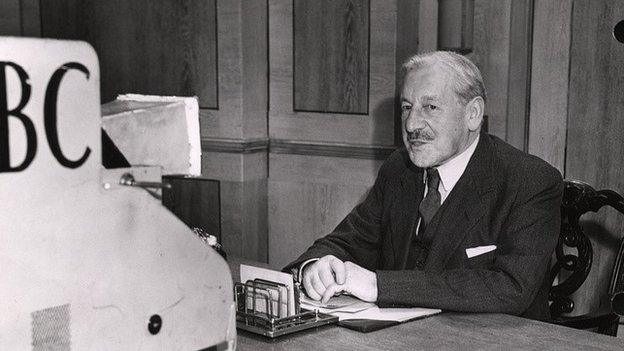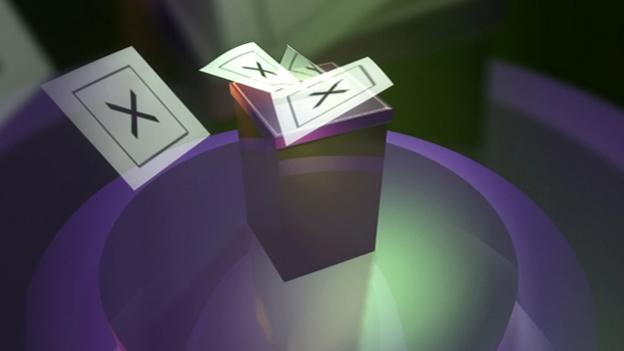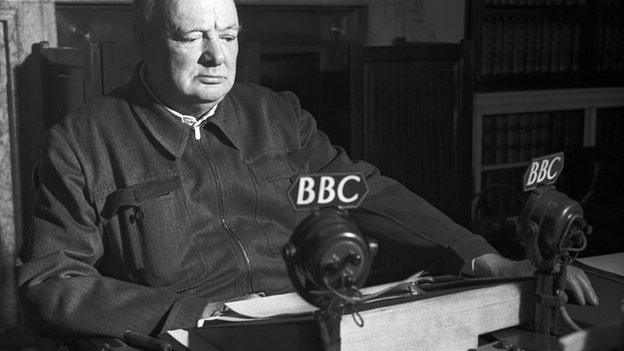The story of the party election broadcast
- Published

"There now follows a party election broadcast." Familiar words which many TV viewers will hear during the election campaign - and which may well prompt an immediate scurry to the kitchen to put the kettle on.
British political parties aren't allowed to buy advertising on radio or television but they do get free airtime to communicate to voters during elections - a tradition which has endured since the early days of broadcasting.
Professor Ralph Negrine, a political communications expert at Sheffield University, has created a website collecting early examples of PEBs, external.

BBC News Timeliner: Party election broadcasts

Historic visual documents or a prompt to change the channel? You can decide by delving into some archive election broadcasts from the three main parties.
Conservatives party election broadcasts, external

"The beginnings of party broadcasting on radio go back to the early foundations of the BBC around the late 1920s and the relationship that John Reith, the first director general of the BBC, established with the political parties," he explains.
"With radio and then television having an enormous reach, the opportunity of communicating with the public important information to help them make decisions about how their life should be run was fundamental to the idea of public service broadcasting."
One of the most memorable early examples was a Conservative radio broadcast in 1945, during the first general election campaign in Britain for a decade.

Winston Churchill's 1945 Conservative election broadcast contained a gaffe which he bitterly regretted
The presenter was a man often described as Britain's greatest hero who had the added qualification of already being a veteran of radio.
But during his live opening broadcast, Winston Churchill made a gaffe he later bitterly regretted. He said Clement Attlee's Labour Party would require "a Gestapo" to establish socialism in Britain.
Attlee retaliated skilfully in his first broadcast, lamenting Churchill's transition from wartime statesman to divisive politician.
Nearly half the adult population was thought to have heard the broadcasts. Labour went on to win a landslide.
Televised party broadcasts began in the 1951 election. In the very first, the Liberal leader, Lord Samuel, read hesitatingly from notes, overran and was cut off by the producer in mid-flow.
But the Conservative broadcast in which the suave TV presenter Leslie Mitchell interviewed the shadow Conservative Foreign Secretary Anthony Eden was much slicker.
Although live, the entire broadcast was rehearsed word for word.
By the 1959 election the parties had started to exploit television's potential.
Tony Benn, a former BBC producer - but in 1959 a Labour MP - fronted three 20-minute broadcasts using interviews, graphics, cartoons and sound effects.
Although Labour lost the election, the broadcasts were seen as innovative and modern.
Yet even by the 1960s, TV party broadcasts in the UK were still failing to match the impact made by American political ads in presidential elections.
One of the most famous, from the Johnson v Goldwater race in 1964, depicted a little girl picking petals from a daisy followed by the countdown to the launch of a nuclear missile.
What was Lyndon Johnson's campaign team suggesting? That if trigger-happy Republican Barry Goldwater won the presidency, he'd blow the world up. When the votes were counted, Goldwater was annihilated.
In contrast, British election broadcasts were regarded as dull. And the politicians were to blame. That's the view of Sir Chris Powell, a veteran of the advertising industry and for many years an adviser to the Labour Party.
"The history of these things is a politician talking to camera and boring the pants off you," he says.
"I remember going to shadow cabinets when the main subject seemed to be whose turn it was to appear in the party political broadcast because this was one of the very rare examples of where you could speak to millions of people unmediated by the media and thus make yourself famous.
"So the claws were out. 'It's my turn', 'No, it's my turn.' Politicians tended to see the broadcasts as a platform for their own careers.
"But over time, it's got a lot more professional," he adds.
As the influence of advertising experts grew, the broadcasts became more ambitious. By the 1980s, the parties were even hiring big name film directors. And a new trend emerged - the "biopic".
Famous examples of this genre included "Kinnock The Movie" from 1987, which depicted the Labour leader making passionate speeches, walking on the Welsh cliff tops with his wife Glenys and giving emotional interviews, all set to rousing classical music.
John Major's "The Journey", showing the prime minister re-visiting his Brixton roots followed in 1992 and included his now famous response to seeing his old home: "Is it still there? It is. It is." The authenticity of which was later called into question when it transpired Mr Major and aides had rehearsed the trip in advance.
Then there was the 1997 reportage-style film featuring Tony Blair at home, with scenes round the kitchen table, made by documentary maker Molly Dineen.
"The electorate like to feel they know the people they're voting for," says Sir Chris.
"The Kinnock movie did that in spades. it increased his personal ratings by something like 30% but interestingly it had no effect on the ratings of the Labour Party."
Well, indeed. Neil Kinnock lost badly in 1987. But Sir Chris says the Blair biopic did have an impact at the ballot box.
"Research was done after the election which indicated the broadcast was a factor in persuading many voters who'd previously voted Conservative to switch to Labour," he says.
"Most big brand advertising is about trying to confirm people in their habits. Often that's exactly what political campaigners are trying to do with these broadcasts."
One politician who eschewed the biopic was Margaret Thatcher.
"She didn't really trust TV," says Charles Lewington, a political communications expert and former Conservative adviser.
"She preferred to tell it straight and the advisers around her felt it was her strongest asset - calling it as it was. She never, for example, went back to her home town. Her advisers were keen to portray her as a stateswoman on the world stage."
You may be surprised at the level of detail discussed by the teams producing PEBs.
Bulldog's testicles
Sir Chris remembers heated arguments during the planning of a 1997 broadcast featuring a bulldog.
"It started with a British bulldog that was stretching on a lead trying to escape with pent up energy. At the end of the broadcast the bulldog broke its leash and ran off into the setting sun with rousing patriotic music."
Discussions focused on whether the bulldog's testicles (he used a slightly fruitier term) were too much for the British public to see and should be airbrushed out. To Sir Chris's disappointment, caution won out and the offending parts were indeed removed from the images.
It has been known for an election broadcast to move centre stage in a campaign, as was the case with the 1992 Labour film, "Jennifer's Ear".
The broadcast showed two girls, both with glue ear, one of whom (Jennifer) suffers in pain while she waits for NHS treatment, while the other goes private and is quickly cured.
"It was one of the most effective pieces of political communication," remembers Sir Chris. "It was certainly novel in that it had almost no words, just picture sequences set to music."
A production triumph maybe, but a huge and distracting political row followed the transmission, after it emerged it had been based on a real-life Jennifer whose family was bitterly divided about the use of her case. Labour later concluded in an internal report that the broadcast was "badly researched" and made the party look "not a little grubby".
Jennifer's Ear was an example of a trend in election broadcasts which has become more prominent - the quest for authenticity.
"There's been a trend towards getting the politicians to take a step back in the films and getting people to do the talking for them," says Charles Lewington.
"We saw it during the European elections when the Tory broadcast featured so-called swing voters expressing surprise that unemployment and the deficit had fallen as much as they had and the Labour Party featured a young entrepreneur who'd struggled to get lending from a bank.
"That works. There's a deep suspicion of politicians nowadays. But the danger of using real voters is they may not be your voters so you need to make sure of their political allegiances before you put them out on air."
In this year's election, the parties face a bigger challenge: fewer people are watching TV and more are getting their information from social media. Mr Lewington prediction was that the parties will adapt by producing broadcasts which can be sliced up and re-packaged.
"We're all very choosy about our content and fewer people are watching prime time television, so the parties will be chunking up their content and dropping it on unsuspecting voters in marginal seats through their Twitter feed and Facebook pages."
If the broadcasters were no longer compelled to provide free airtime to the political parties at election time, would the public really mind? Maybe not, but Sheffield University's Ralph Negrine says the obligation should remain.
"Party broadcasts remain an important part of the political process. We might not wish to watch them but the principle established by John Reith in the 1920s remains constant. Political parties do need to find ways of communicating with the public at large and if for that reason only they should remain. "
Listen to the report on party election broadcasts.
Catch-up with all the Election 2015 party election broadcasts